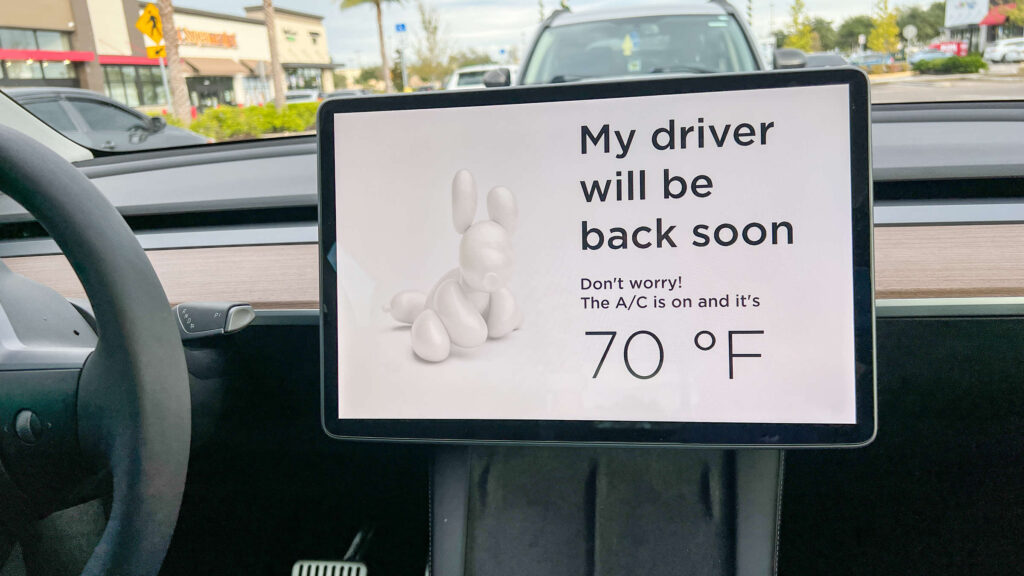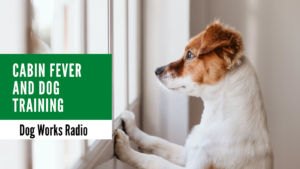As more of our clients at Alaska Dog Works, including ourselves drive EVs, especially the Tesla Model Y, we’re getting the same question: “Is Dog Mode safe and what’s new?” Short answer: Dog Mode remains one of the most thoughtful in-car pet-safety features available, and recent software updates have made useful refinements. But like any tech, you should understand its limits, build redundancy, and practice smart leave-your-dog procedures.
Below, we break down what Dog Mode is, the latest Model Y updates, and a field-tested checklist for using it in Alaska’s unique conditions.
What Dog Mode Does (and How It Keeps Your Pup Comfortable)
Dog Mode is a climate-control setting that keeps your Model Y’s cabin at a temperature you choose while the vehicle is parked. The center screen displays a large message, “My driver will be back soon” and the current cabin temperature, to reassure concerned passersby. You can leave your dog inside for a short errand while the heater or A/C maintains comfort. Tesla groups Dog Mode with “Keep Climate On” and “Camp Mode” in the owner’s manual, noting these modes keep climate running while the car is in Park. Notatesla App+1
From your Tesla app, you can check interior temperature and make remote adjustments, helpful if a line at the post office runs longer than expected. Real-world reports also highlight critical alerts: if the vehicle struggles to maintain the set temperature, owners receive phone notifications so they can return quickly. Notatesla App
What’s New: 2025 Software Tweaks You’ll Notice
In August 2025, Tesla rolled out software version 2025.32 with multiple improvements, including updates to Dog Mode and a new Low Power Mode to conserve energy when parked with a low battery state of charge. Release notes also indicate you can now set a minimum Dog Mode temperature of 64°F (18°C), a small but meaningful adjustment for comfort and efficiency planning. Tesla Oracle
These refinements arrive after Tesla addressed widely reported 2024 software bugs that occasionally disrupted Dog Mode. Independent outlets documented issues tied to the 2024.20.1 update and reported that Tesla advised owners to refrain from using Dog Mode until a fix was deployed. The takeaway: software evolves; always keep your car updated and verify Dog Mode is functioning before you walk away. InsideEVs+2Road & Track+2
Energy Use: How Long Can You Safely Leave Dog Mode On?
Energy consumption varies with outside temperature, sun load, wind, and whether you preconditioned the cabin. Community testing and accessory makers generally estimate ~1–3% battery per hour in Dog Mode under moderate conditions. Extreme heat or deep winter can increase draw. Plan conservatively, and remember that very low battery can curtail features. Tesla Ausstatter
Pro tip for Alaska: Cold-soaked batteries are less efficient, and warming the cabin from below-freezing takes more energy than maintaining an already warm cabin. Precondition while plugged in at home or at a charger, then let Dog Mode maintain, not create, comfort.
How to Use Dog Mode Safely (Our Alaska Dog Works Checklist)
1) Start with a healthy margin of battery.
Aim for 50%+ state of charge when you expect to use Dog Mode in hot or very cold weather. It gives you headroom if lines run long or temperatures swing. Tesla’s manual emphasizes using Dog Mode for hot weather errands; the same logic applies to cold snaps, prepare before you leave the car. Tesla
2) Verify function before you step away.
After tapping Climate → Dog, confirm the set temperature is correct and the on-screen message is visible. Peek at the app for cabin temp stabilization before exiting. Given the 2024 incident history, a 10-second check is worth it. InsideEVs+1
3) Use shade and good parking choices.
Even with A/C, a sun-soaked cabin can demand more power. Whenever possible, choose shaded spots and use sunshades.
4) Build redundancy with a secondary temp alert.
While the Tesla app provides critical alerts, we recommend a standalone Bluetooth temperature sensor (with your own phone alerts) clipped to your dog’s crate or harness. Two alert paths are better than one, especially where cellular coverage can be spotty.
5) Crate for safety and calm.
A travel-rated crate reduces pacing, pawing at glass, or door bolting if someone opens a door to “help.” For northern breeds, a crate also helps them settle into a comfortable curl where they self-regulate heat more efficiently.
6) Hydration & ventilation basics.
Offer water in a spill-proof bowl. In moderate weather, cracking a window is fine, but recognize Dog Mode already controls climate and disables window controls from paws, which helps prevent accidental escapes. Reddit
7) Timebox your errand.
Dog Mode isn’t a license to leave dogs indefinitely. Keep errands short and use the app to monitor. If cabin temp drifts or alerts fire, return immediately. Notatesla App
8) Extreme cold adjustments.
In sub-zero Anchorage or Interior Alaska days, set a slightly warmer target than you think you need (e.g., 66–68°F). Warm air rises; if your dog is crated low in the cargo area, you’ll maintain a more even micro-climate around them. Pre-warm blankets can help, but avoid heavy layering that traps moisture against the coat.
When NOT to Use Dog Mode
There are days when no vehicle, EV or gas, can guarantee a safe cabin environment for longer than a very short errand:
Heat waves with intense sun load (rapid temp spikes if climate were to fail).
Polar nights with severe winds where heat loss accelerates.
Remote areas with poor cell coverage (alerts might be delayed).
In those cases, choose curbside pickup, bring your dog along on-leash, or skip the stop. Common sense beats convenience every time.
Why This Matters to Our Clients
At Alaska Dog Works, many of our service-dog and therapy-dog teams depend on consistent routines. Dog Mode. used knowledgeably, lets handlers run a quick errand between training sessions without risking heat stress or cold shock. It’s not a replacement for supervision; it’s a tool that, paired with training and planning, raises the safety bar.
We also appreciate the direction of Tesla’s updates: incremental improvements to Dog Mode and new Low Power Mode options reflect a maturing ecosystem that recognizes real pet-owner needs. Keep your car updated, run the checklist above, and make conservative decisions based on that day’s weather. Tesla Oracle
Quick Start: Your 30-Second Dog Mode Routine
Precondition while plugged in (or after a drive).
Set Dog Mode (Climate → Dog) and verify the on-screen message and temp. Tesla
Check the app for stable cabin temperature before walking away; keep the trip short. Notatesla App
Carry redundancy (Bluetooth temp sensor) and water; crate your dog.
Return immediately to any alert, or if outside conditions worsen. Notatesla App
Final word
Dog Mode on the Tesla Model Y is a thoughtful innovation, and the 2025 updates continue to polish the experience. Used with the same risk-aware mindset we teach in our training programs, it’s a helpful tool for quick, safe stops with your dog, not a set-and-forget solution. If you’d like a personalized pre-trip checklist based on your dog’s breed, coat, and training goals, schedule a strategy call with Alaska Dog Works. we’ll tailor a routine that fits Alaska’s terrain, weather, and your daily life.
Sources & Notes:
Tesla Owner’s Manual (Model Y): Dog/Keep Climate/Camp Mode overview and hot-weather guidance. Tesla+1
Release notes: 2025.32 adds Dog Mode refinements and Low Power Mode; minimum temperature setpoint detail. Tesla Oracle
2024 Dog Mode bug coverage (context for verification and updates): InsideEVs and Road & Track. InsideEVs+1
Dog Mode behavior and in-app/alert ecosystem in practice. Notatesla App
Approximate energy consumption guidance to plan battery margin. Tesla Ausstatter
Disclaimer: Always confirm your current software version and read the latest Tesla release notes and manual before relying on any feature.










